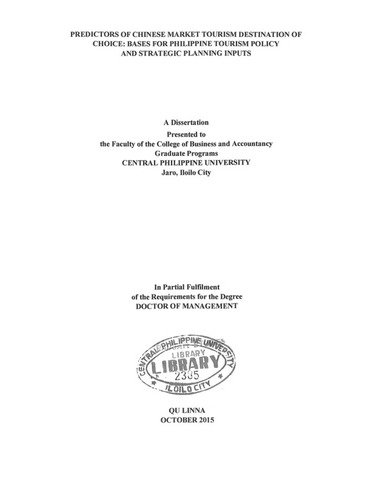Predictors of Chinese market tourism destination of choice: Bases for Philippine tourism policy and strategic planning inputs

Page views
996Date
2015Author
Thesis Adviser
Defense Panel Chair
Share
Metadata
Show full item record
Abstract
This study aimed to determine the predictors of Chinese market tourism destination of choice as basis for the Philippine tourism policy and strategic planning inputs. Specifically, the study aimed to 1) describe the profile of the respondents in terms of personal-related factors such as age, gender, education, working status, type of occupation, family average monthly income, place of origin, last travel as tourist, place or country last visited, number of nights stayed in the place, number of companions, and travel arrangements; 2) describe the respondents’ choices of product or service attributes such as transportation, accommodation, culture, recreational activities, environmental concerns, safety, food and available tourism information.; 3) describe the respondents’ tourism destination of choice; 4) determine which among the personal-related factors and product or service attributes are significantly related to the respondent’s tourism destination of choice, and; 5) determine which among the personal-related factors and product or service attributes are the strongest predictors of respondents’ tourism destination of choice. Descriptive exploratory research design was used utilizing the quantitative information that were collected using a one-shot survey. The study population were the potential tourists from City of Beijing, China.
The average age of the respondents was 31.51 years old. There were a little more female than male respondents, majority obtained a college or post-secondary education, employed during their travel as professionals with an average family income of 16,120 CNY. Majority of them had travelled within the year and half of them visited places outside of China. Of those who traveled outside of China, only 3 visited the Philippines. Majority preferred to organize their travel itinerary by themselves, stayed 4 to 7 nights at the destination place with 2-3 companions. The majority of the respondents chose air transport and hotel for accommodation and get tour information from their relatives or friends. All of them considered transportation, culture, environmental concern, safety, food and delicacies as very important factors in choosing a place they visited while accommodation, recreational activities and available tourism information were considered as important factors.
More than half of the respondents choose outbound tour than inbound tour and only 11 out of 316 respondents planned to go to the Philippines as their destination of choice. The most popular destinations for the respondents are the places within China and rest of Asia and Africa.
Gender and number of nights stayed were the only personal-related factors found to be significantly related to tourism destination of choice. A combination of the four variables: gender, number of nights stay, availability of recreational activities and tourism information were found to be good predictors of tourism destination of choice and among the four variables, gender was found to be the strongest predictor of tourism destination of choice. Female tourist who plan to stay three or less nights in a place where there are recreational activities and available tourism information is more likely to choose the Philippines as her tourism destination of choice.
The Philippine government may strengthen its tourism initiatives by making the tourism information available to its target markets especially to female Chinese tourism market. They can take advantage of the use of their tourism website to provide up-to-date tourism information especially on recreational activities and tourism packages that include options for over-night stay. The government may also consider exploring the possibility of developing a more integrated tourism activities at the national or provincial level so that tourists may be provided with a more integrated tourism recreational activities that encourages long overnight stay.
Description
Abstract only
Suggested Citation
Linna, Q. (2015). Predictors of Chinese market tourism destination of choice: Bases for Philippine tourism policy and strategic planning inputs (Unpublished Doctoral dissertation). Central Philippine University, Jaro, Iloilo City.
Type
DissertationSubject(s)
Keywords
Department
School of Graduate StudiesDegree
Doctor of ManagementShelf Location
GSL Theses 658.0072 Q2
Physical Description
xiv, 150 leaves
Collections
- Doctor of Management [20]
Related items
Showing items related by title, author, creator and subject.
-
"Acceptability of Guin-Asyan Dako as a potential tourism destination"
Franco, Lesley; Magno, Nycel V.; Payas, Fhatricia Jhoy M.; Samulde, Sarah June (Central Philippine University, 2024-06)This study aimed to determine the acceptability of Guin-Asyan Dako as a potential tourism destination using a quantitative descriptive research design. The study involved 332 respondents who were voluntarily available ... -
Growth drivers and sustainable rural tourism in Fujian Province, China
Qinyou, Li; Dusaran, Reynaldo N. (Central Philippine University, 2024-12)This study assessed rural tourism growth drivers and sustainable practices in Fujian Province, China. Conducted from October 2023 to June 2024 with 307 participants, it reveals insights into the sector. Findings show a ... -
Promoting San Rafael as a secret gateway to Central and Northern Iloilo
Gardose, Marian Dorothy J.; Urbina, Hanna Clyscia P.; Deanon, Stefany B. (Central Philippine University, 2024-01)Situated in the northern part of Iloilo, San Rafael, a 5th class municipality with a population of 19,254, remains a relatively undiscovered gem despite its captivating beauty and historical heritage. This study explores ...




